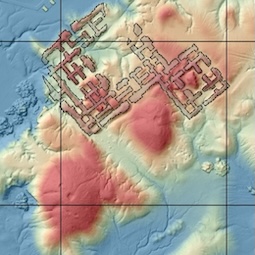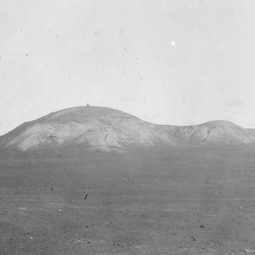The two ziggurats on Tell Ingharra
Tell Ingharra is home to two ziggurats: a large one set on the southwest side of the temple of Ishtar and a small one on its southeast side. Both are about 8 to 10 metres high. These ziggurats are over four thousand years old: they were built during the Early Dynastic period (2900-2334 BC), when other monumental buildings like Palace A began to be constructed in the city (Zaina 2020: 14, 85). Archaeologists believe that these ziggurats were probably built at different times (Zaina 2020: 39-40). Cuneiform texts tell us that one was called in Sumerian the E-kur-mah, "the house of the exalted mountain" (this was Ishtar/Ninlil's house), and the other the E-melam-mah, "the house, exalted radiance of Enlil" (Dalley 20023: 33).
 [/kish/images/sbah-two-ziggurats-large.jpg]
[/kish/images/sbah-two-ziggurats-large.jpg]1. Map of the Temple of Ishtar and its ziggurats, May 2024. Source: State Board of Antiquities and Heritage, Iraq
When the Temple of Ishtar was built in the Neo-Babylonian period, these ziggurats already existed, but they were in a great state of disrepair. So when Neo-Babylonian builders began to erect the temple, they not only cut deep into them to make space, they also set the temple on the ziggurats' platform, perhaps planning to restore the two ziggurats later (Moorey 1978: 85).
Tell Ingharra's two ziggurats were explored by the OFME. The smaller one was excavated on only one occasion by Mackay and his team (Moorey 1978: 85 fn 25). But the larger ziggurat was the focus of the OFME's work for several seasons (Moorey 1978: 87-88).
 [/kish/images/ofme-eastern-kish-large.jpg]
[/kish/images/ofme-eastern-kish-large.jpg]2. "View (from Mound W) of the massive temple area of Eastern Kish". Source: Field Museum OFME Photo Album 140, p. 63 (Neg. No. 175, 1920s)
Once they began work, the team was surprised by the shape of the baked bricks used to build the ziggurat. They were a shape known as "plano-convex bricks", a little like a bread roll, and some still bore the thumb mark of their maker in their centre (Moorey 1978: 87). Mackay also observed that the ziggurat was standing over a small plano-convex building dated to an earlier date (Moorey 1978: 87).
Little is known about the ziggurat because the reports published were too general. But some information survives in Watelin's letters to the expedition director, Stephen Langdon. For example, while exploring the facade of the large ziggurat, Watelin found part of a cemetery which contained chariots buried with their riders, below the brickwork of the ziggurat's edge (Zaina 2020: 110).
We do not know how these two ziggurats were shaped or how many terraces they had. But archaeologists believe that the large ziggurat could have looked like a staged tower, not a temple on a platform (Moorey 1978: 88-89; Zaina 2020: 109).
Many cylinder seals from the Early Dynastic III to Old Babylonian periods discovered at Kish were carved with the image of a temple, with the praying area looking like a platform built on wood (Moorey 1978: 89). But these images are not necessarily a true representation of what the ancient artists and sculptors could see in the city, and they cannot be relied upon to reconstruct the architecture of the ziggurats (Moorey 1978: 89, fns 37 and 38).
The ziggurats were abandoned toward the end of the Early Dynastic period (2900-2334 BC), when the city appears to have been destroyed (Zaina 2020: 135, 148; Gibson 1972: 87). This destruction could be the result of the city's conquest by En-shakush-Ana, the ruler of Uruk, who even named his first year of reign as "the year when En-shakush-Ana besieged Kish" (Frayne 2008: 429). It is possible that later builders attempted to restore these ziggurats, but no conclusive evidence has yet been found (Zaina 2020: 135).
In 2003, the US military established a base on top of the ziggurats, as well as living quarters around them. This resulted in damage to the mounds, not only because of the weight of equipment and vehicles around the temple of Ishtar, but also because they used the area in front of the temple as a garbage dump (Gibson 2023: 66). Empty ammunition shells can still be found around the ziggurats and the temple. The site is safe, however: it was last checked for mines and explosives by the Iraqi authorities in August 2024.
03 Jul 2025
Nadia Aït Saïd-Ghanem
Nadia Aït Saïd-Ghanem, 'The two ziggurats on Tell Ingharra', The Forgotten City of Kish • مدينة كيش المنسية, The Kish Project, 2025 [http://oracc.org/MoundsofKish/TellIngharra/Twoziggurats/]